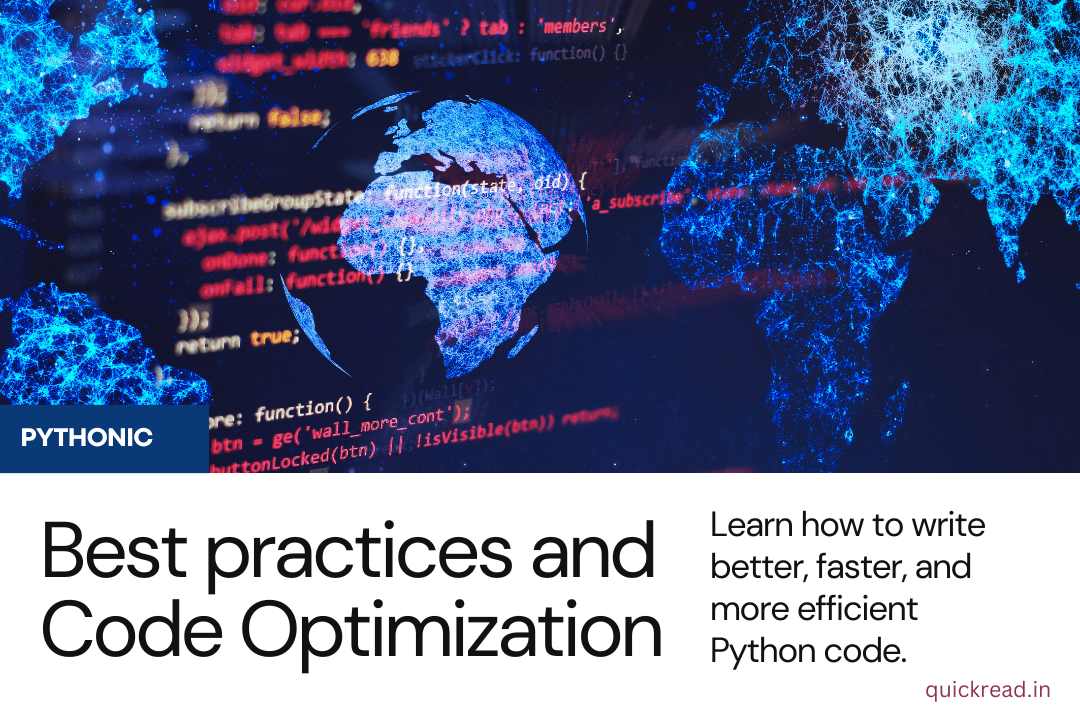Introduction
Writing high-quality Python code requires awareness and experience to develop good habits. In addition, optimizing performance bottlenecks and inefficient code is crucial for production-grade applications.
In this comprehensive guide, we’ll explore Python best practices and code optimization techniques including:
- General code style guidelines
- Writing idiomatic and Pythonic code
- Structuring and modularizing code
- Handling exceptions and errors
- Unit testing properly
- Debugging effectively
- Benchmarking and profiling
- Optimizing expensive loops
- Speeding up array operations
- Reducing overall memory usage
- Leveraging multiprocessing
Mastering these areas will level up your ability to write Python code that’s readable, reliable and high-performing. Let’s jump in!
Python Style Rules and Guidelines
Python has a well-established philosophy toward code readability and consistency. Follow these coding style rules:
- Follow PEP 8 – The official Python style guide outlines standards like 4 space indents, 79 character line length, spacing around operators etc. Adhering to PEP 8 makes your code familiar to any Python developer.
- Use descriptive names – Name functions, variables, classes to be clear rather than abbreviated. Exceptions can be made for idiomatic short names like i for indexes.
- Prefer snake_case over camelCase – Snake case is the convention for function names, variables, and filenames in Python.
- Use whitespace properly – Surround operators with spaces, don’t have extraneous whitespace in empty blocks. Maintain consistent whitespace to align code.
- Limit line length – Break up long lines that exceed 79 characters for readability. PEP 8 recommends using parentheses for line continuations.
- Add comments appropriately – Use comments to explain complex blocks of code. Avoid redundant comments that state the obvious.
Adhering to Python’s style guidelines creates familiar, readable code any Python developer can follow.
Writing Pythonic and Idiomatic Code
Beyond styling, learn to write idiomatic code that conforms to Python’s elegance and intended usage:
- Prefer dictionaries over switch/case – Use dicts to map conditions to functions instead of switch/case blocks.
- Avoid getter and setter methods – Use Python’s readable attributes and assignment instead.
- Use list comprehensions – List and dictionary comprehensions provide a concise yet readable way to transform and return collections.
- Unpack sequences – Unpacking iterables into variables is cleaner than using indexes.
- Prefer enumerate() over range() – Provides readable loops that iterate an index and value rather than manual indexing.
- Use context managers – Leverage context managers like ‘with’ for resource allocation/cleanup.
- Make use of built-ins – Use Python’s vast, expressive standard library rather than reinventing basic functionality.
Python offers great power through simplicity. Embrace idioms that follow the “Pythonic” way.
Modular and Maintainable Code
Good structure is key for complex and maintainable Python programs:
- Modules – Break code into logical modules that group related functionality.
- Packages – Further organize modules in nested packages.
- Limit interactions – Minimize inter-module interactions for loose coupling.
- Abstract classes – Use standard ABCs for polymorphic interfaces.
- Zen of Python – Follow principles like short, single-purpose functions.
- Minimize global state – Avoid relying on global variables for clear boundaries.
- Main guard – Check
if __name__ == '__main__'to allow module execution vs import. - Type hints – Use type hints for clarity even if not enforcing.
Logical structure and minimal coupling ensures code remains readable and maintainable as complexity increases.
Exception Handling Best Practices
Handle exceptions cleanly using best practices:
- Document exceptions – Declare exceptions raised with docstrings and comments.
- Handle exceptions precisely – Catch specific exception types rather than broad Exception.
- Print exceptions – Log caught exceptions before handling.
- Clean up resources – Use finally blocks to release allocated resources.
- Reraise exceptions – Re-raise the original exception after cleanup rather than new errors.
- Use context managers – Utilize context managers to automatically handle enter/exit logic.
- Define custom exceptions – Create meaningful exception types specific to your project.
- Return error information – Have exceptions return debugging info programmatically when caught.
Robust error handling prevents crashes and avoids silent failures.
Proper Unit Testing
Unit testing saves countless hours by preventing bugs and enabling refactoring. Build an effective test suite:
- Isolated tests – Each test case should test one specific behavior.
- Follow naming conventions – Like
test_function_namefor test functions. - Assert liberally – Fail fast by checking all assumptions with asserts.
- Mock dependencies – Isolate code under test by mocking out external dependencies.
- Parametrize input – Test functions over different input arguments.
- Simplify logic – Break complex components into simpler functions to test each part.
- 100% coverage – Ensure the test suite covers every single line of application code.
- Run often – Execute tests automatically on every code change to catch regressions.
Thorough, automated testing eliminates entire classes of bugs and enables more rapid development.
Effective Debugging Techniques
Bugs and unexpected behavior inevitably arise. Debug systematically:
- Reproduce – Isolate exact steps to reproduce the failure.
- Print statements – Log values and trace execution flow at key points.
- Leverage IDE – Use IDE debugger and set breakpoints for inspection.
- Simplify inputs – Reduce large test cases into smaller examples revealing the issue.
- Check assumptions – Validate the code matches requirements and specifications.
- Compare differences – Contrast similar segments of code that behave differently.
- Measure performance – Profile CPU and memory usage for optimization clues.
- Take a break – Step away for a fresh perspective. Often sparks new ideas!
Persistence and a methodical process will lead to that ‘Eureka’ moment.
Benchmarking Performance
Assess performance by benchmarking Performance code snippets:
import timeit
def func_1():
# ...
def func_2():
# ...
time_1 = timeit.timeit(func_1, number=1000)
time_2 = timeit.timeit(func_2, number=1000)
print(f'Method 1: {time_1}')
print(f'Method 2: {time_2}')This quickly indicates slower functions to optimize. Profile long running applications using cProfile or line_profiler.
Optimizing Expensive Loops
Slow loops are common Python performance bottlenecks. Speed them up:
- Cache invariant calculations – Move constant computations outside loops.
- Pre-allocate outputs – Preallocate arrays and collections to proper size instead of appending.
- Use better data structures – Sets and dicts are faster than lists.
- Vectorize code – Use NumPy vector operations instead of slow Python loops when possible.
- Filter early – Return or continue loop based on cheap early checks.
- Avoid anti-patterns – Generator expressions can be faster than functions for transforms.
Understanding performance nuances of Python datatypes and loops leads to huge speedups.
Faster Array Processing
Arrays often cause unexpected sluggishness. Optimize common operations:
- Pre-allocate arrays if you know output size. Appends get expensive.
- Slice arrays – Use
array[:]instead of copying entire array. - Stack 2D arrays – Stacking 1D arrays is faster than nested 2D arrays.
- Use NumPy – NumPy performs vectorized array operations in fast C loops.
- Avoid deletes – Removing array elements by index forces re-indexing.
Internally, Python arrays are variable-length objects. Understand their performance characteristics.
Reducing Memory Usage
Python’s dynamic nature and garbage collection incur memory overheads. Reduce waste:
- Reuse objects – Mutable objects can be reused rather than reallocated.
- Limit variable scope – Minimize global variables, reuse temporaries.
- Buffer I/O operations – Set buffer size rather than loading entire file into memory.
- Release references – Delete no-longer used references explicitly.
- Share commonly used objects – Use interned strings, frozensets for duplicates.
- Use NumPy – NumPy uses efficient buffers to reduce overheads.
- Monitor usage – Profile memory with memory_profiler to identify leaks or waste.
Careful memory usage ensures Python programs stay lean and efficient.
Leveraging Multiprocessing
For parallelizable problems, use multiprocessing:
import multiprocessing
def task(data):
# Process data
if __name__ == '__main__':
pool = multiprocessing.Pool(processes=4)
inputs = [...]
pool.map(task, inputs)This evaluates task in parallel across multiple inputs using the available cores.
Multiprocessing is great for speeding up numerical processing, aggregations, web scraping, and more.
Conclusion
Mastering Python’s coding style, idioms, testing, debugging, and optimization techniques levels up programming skill.
The key techniques we covered include:
- Following Pythonic style and idioms
- Structuring for modularity and loose coupling
- Properly handling exceptions
- Reducing complexity and testing thoroughly
- Debugging effectively through instrumentation
- Benchmarking bottlenecks and optimizing
- Multiprocessing for parallelism
Adopting best practices leads to robust production-ready codebases. Python’s community standards distill decades of collective wisdom around clean code and maintainability.
Learning never stops – there are always new optimizations and techniques to master. But investing in these foundational skills will boost all your future Python programming endeavors.
Frequently Asked Questions
Q: What are some key Python style rules to follow?
A: PEP 8, descriptive names, prefer snake_case, whitespace around operators, line length under 79, avoid redundant comments.
Q: What makes code “Pythonic”?
A: Idioms like dict over switch statements, list comprehensions, context managers, leveraging built-ins, and more.
Q: How can I structure complex Python codebases?
A: Break into logical modules and packages. Minimize coupling between components and global state. Use typing for clarity.
Q: What are some best practices for exception handling?
A: Document exceptions raised, catch specific exception types, clean up resources, reraise exceptions after handling, return debug info programmatically.
Q: What techniques help optimize slow Python code?
A: Caching, pre-allocation, better data structures, vectorization, multiprocessing, Cython extensions.
Q: How can I profile the performance of my Python code?
A: Use the timeit, cProfile, line_profiler modules to assess bottlenecks.
Q: What are someeffective debugging strategies?
A: Reproduce issue reliably, print key state, use debugger breakpoints, simplify inputs, validate assumptions, compare similar code.


